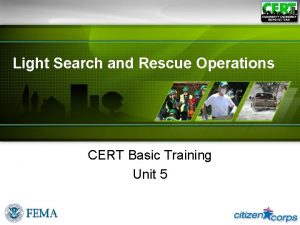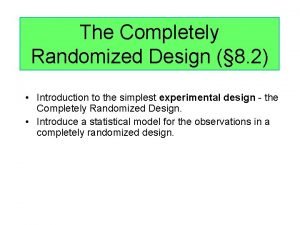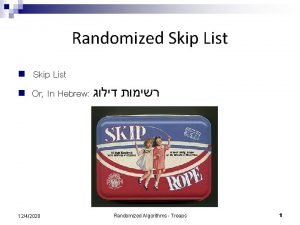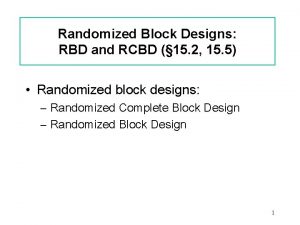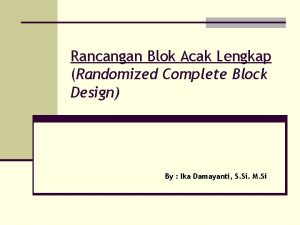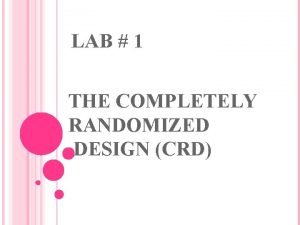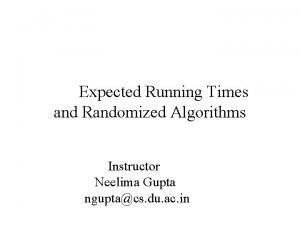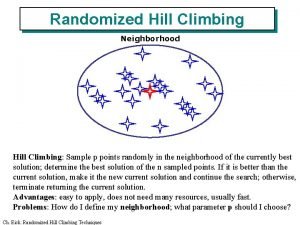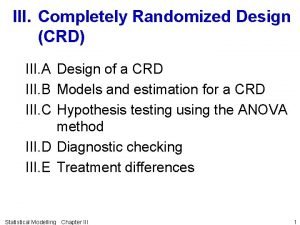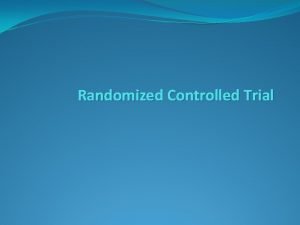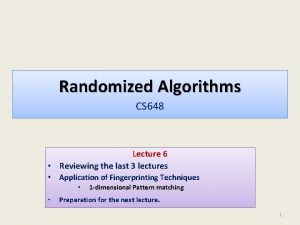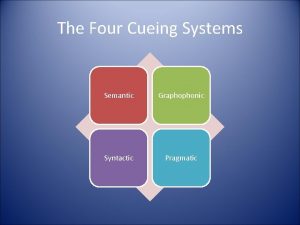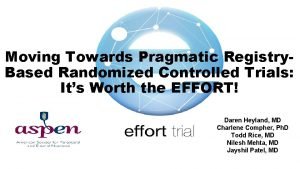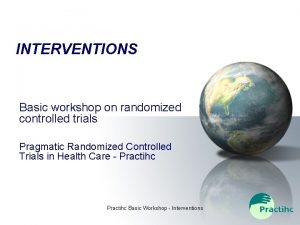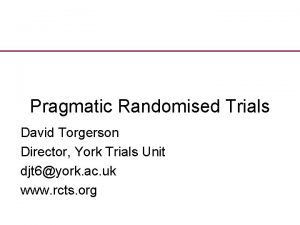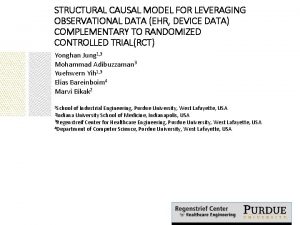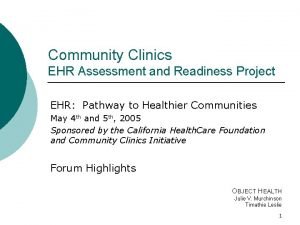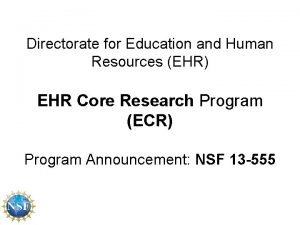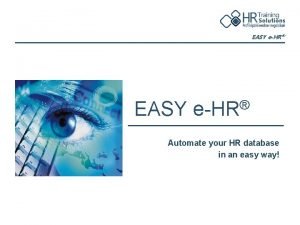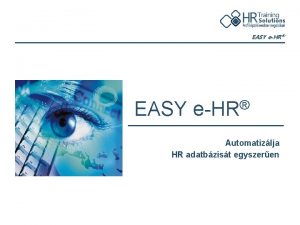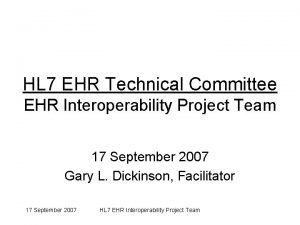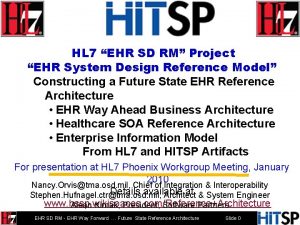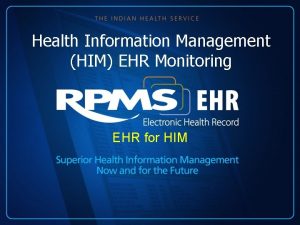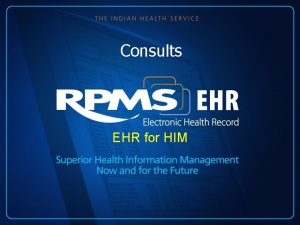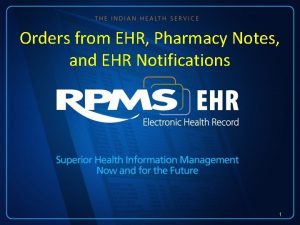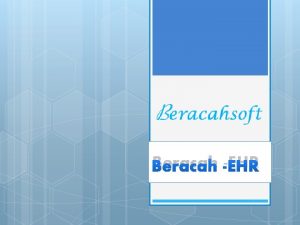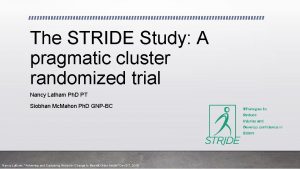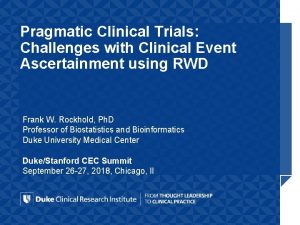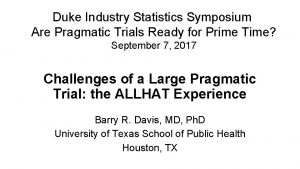Leveraging EHR Data for Pragmatic Randomized Trials in







































- Slides: 39

Leveraging EHR Data for Pragmatic Randomized Trials in Learning Health Care Systems in the United States – Lessons Learned from the ADAPTABLE Trial Matthew T. Roe, MD, MHS Professor of Medicine, Senior Investigator Duke Clinical Research Institute

Conflict of Interest Statement – Matthew T. Roe, MD, MHS § Research Funding: – American College of Cardiology, American Heart Association, Astra. Zeneca, Familial Hypercholesterolemia Foundation, Ferring Pharmaceuticals, Janssen Pharmaceuticals, Myokardia, Patient Centered Outcomes Research Institute, Sanofi-Aventis § Consulting/Honoraria: – Amgen, Ardea Biosciences, Astra Zeneca, Eli Lilly, Elsevier Publishers, Flatiron, Janssen Pharmaceuticals, Novo Nordisk, Pfizer, Regeneron, Roche-Genentech, Sanofi-Aventis, Signal Path Publicly listed on www. dcri. org/about-us/conflict-of-interest

What is a Learning Health Care System? § The Institute of Medicine’s Vision: – Research happens closer to clinical practice – Scientists, clinicians, and administrators work together – Studies occur in everyday practice settings – Electronic medial records are linked and mined for research – Recognition that health system data exist for the public good § Evidence informs practice and practice informs evidence

Principles for Conducting Pragmatic Clinical Trials in Learning Health Care Systems 10/2016 § Leverage available medical data from electronic health records (EHRs) to identify potentially eligible patients § Recruit large samples of patients within healthcare systems to limit selection biases and provide more generalizable results that are relevant to routine practice § Simplify baseline and follow-up data collection through systematic direct patient contact and surveillance of multiple, electronic data sources § Ascertain endpoints as part of routine healthcare delivery and administrative claims retrieval

Framework for Evolution and Expansion of Pragmatic Trials

Pragmatism from Beginning to End of Trial Lifespans

Options for Using EHR Data to Streamline Clinical Trials Pre-study • Assess sites’ use of EHR to facilitate research • Usability of inclusion and exclusion criteria • Define & refine cohort • Cohort’s interaction profiles with health system • Feasibility analysis • Recruitment plan Study Setup • Utilize EHR to identify local subjects/population • Feasibility dashboard • Embed encounter instructions and site content into EHR • Pre-consent & study specific consent • Model outcomes Recruitment • Incorporate screening criteria into EHR for • Scheduling subjects • Contacting subjects • Recruiting subjects • Alert provider of patient eligibility • EHR Health Portals • Patient opt in/out for types of studies Study Conduct • Trials specific data capture at care delivery • Auto-populated CRFs fields from EHR • Extract data to facilitate work of study coordinator • Rules, Alerts & Checks • • Data completeness Quality compliance Hospitalization/AEs Event rates • Patient retention and education

When to Engage Patients with Pragmatic Trials: Early, often, always from bench to bedside and back ⁻ Provide input on study design such as barriers to participation, study endpoints, and risk/benefit perception ⁻ Provide information on unmet need and therapeutic burden ⁻ Interest of research question to participant community Develop the study concept Secure funding ⁻ Participants work with sponsor or researcher to support funding applications and models Prepare the study protocol Create study procedure ⁻ Help finalize eligibility criteria within the study protocol ⁻ Assist in creating the informed consent process and form Implement the study ⁻ Advise study recruitment strategies ⁻ Support recruitment of study participants Monitor the study Analyze data and interpret results ⁻ Advise on postmarket study design ⁻ Provide feedback on how the participant community will view results Disseminate study information ⁻ Serve on a Data Safety Monitoring Board ⁻ Thank participants ⁻ Provide recommendation s for revising study protocol if changes need to be made ⁻ Share findings in laypeople language ⁻ Update on progress ⁻ Better understand adherence, persistence, access, impact FDA review and approval Postapproval studies ⁻ Work with trial team to develop plns for returning of individual and aggregate results; Contrubute to lay summary devellopment ⁻ Write newsletter articles or blog posts about results ⁻ Co-present results with sponsors and researcher at scientific conferences or in Participant communities

Quality by Design for Pragmatic Trials § Simple hypothesis that can be tested and addressed in a large and readily accessible patient population with high quality trial design, conduct, and execution – Patient-directed, patient-centric approach § The definition of a quality pragmatic trial requires – Appropriate engagement and randomization of a diverse, representative patient population – Confirmed receipt of and compliance/adherence with the randomized treatment or intervention – Complete ascertainment and evaluation of all potential efficacy and safety events – Identification of any major GCP issues

ADAPTABLE Background

PCORnet® embodies a “network of networks” that harnesses the power of partnerships 20 Patient-Powered Research Networks (PPRNs) + 13 Clinical Data Research Networks (CDRNs) = PCORnet A national infrastructure for people-centered clinical research

PCORNet Research Network – Uniting Data from Patients, Clinicians, Health Systems

ADAPTABLE Study Design 15, 000 patients with known ASCVD + ≥ 1 Enrichment Factor Patients identified by research networks in PCORnet through EHR/CDM searches using a computable phenotype that classifies inclusion/exclusion criteria Patients provided with trial information and link to e-consent on a web portal; † Randomized treatment assignment provided directly to patient ASA 81 mg QD ASA 325 mg QD Electronic patient follow-up for PRO’s: Every 3 or 6 months Supplemented with searches of EHR and claims data Duration: Enrollment over ~ 3 years; maximum follow-up of ~ 4 years Primary Efficacy Endpoint: Composite of all-cause mortality, hospitalization for MI, or hospitalization for stroke Primary Safety Endpoint: Hospitalization for major bleeding Participants without internet access will be consented and followed via a parallel system. † Clinical. Trials. gov: NCT 02697916

ADAPTABLE Clinical Data Research Network (CDRN) Distribution and Enrollment Clinical. Trials. gov: NCT 02697916

ADAPTABLE Lessons Learned – Identification and Recruitment of Trial Participants Using EHR Data

ADAPTABLE Inclusion Criteria – Computable Phenotype Known ASCVD • Prior MI OR • Prior revascularization (PCI or CABG) OR • Prior angiogram showing significant CAD OR • History of chronic ischemic heart disease, CAD, or ASCVD ≥ 1 enrichment factor: • Age ≥ 65 years • Creatinine ≥ 1. 5 mg/d. L • Diabetes mellitus • Known 3 -vessel CAD • Cerebrovascular disease • Peripheral arterial disease • Current smoker • Known LVEF < 50% • Chronic systolic or diastolic heart failure • SBP ≥ 140 (within past 12 mos) • LDL ≥ 130 (within past 12 mos) Electronic Patient Outreach Clinical. Trials. gov: NCT 02697916

Electronic-Facilitated Recruitment Approaches Utilized in ADAPTABLE Electronic, computable phenotype used to query local EHR databases to facilitate widespread screening of large numbers of potentially eligible patients Patient Outreach and Recruitment Approaches § Direct Mail and Email (messages locally customized with input from patient representatives) § Via health system patient portals such as “My. Chart” § “In-Clinic” Recruitment (EHR Alerts to clinic providers, Tabletbased recruitment during clinic encounters, promotion of trial during clinic) Potential patients given Golden Ticket numbers and directed to the Adaptable web portal for confirmatory screening and electronic, web-based informed consent Clinical. Trials. gov: NCT 02697916

www. adaptablepatient. com Clinical. Trials. gov: NCT 02697916

Site Approach and Enrollment Update CDRN Site Total Golden % of Eligible Total Number Tickets entered Approached Enrolled Eligible Approached Entered per Approached # Noninternet Enrolled % Enrolled Per Enrolled Last Golden Ticket Approached Week Entered Mid-South REACHnet Vanderbilt Duke Ochsner 28, 153 20, 127 16, 968 23, 565 11, 136 14, 960 84% 55% 88% 3, 575 2, 685 1, 349 15% 24% 9% 2, 159 1, 644 727 396 310 303 9% 15% 5% 60% 61% 54% 14 6 8 One. Florida GPC Mid-South Pa. TH GPC NYC-CDRN GPC U of Florida KUMC UNC UPMC Iowa Montefiore MCW 17, 287 21, 944 26, 426 20, 806 19, 665 4, 383 14, 697 7, 047 13, 768 12, 869 17, 576 16, 703 2, 739 11, 761 41% 63% 49% 84% 85% 62% 80% 823 1, 087 1, 785 1, 691 978 638 1, 195 12% 8% 14% 10% 6% 23% 10% 650 590 584 546 524 491 448 214 26 82 23 126 304 5 9% 4% 5% 3% 3% 18% 4% 79% 54% 33% 32% 54% 77% 3 7 0 0 7 2 6 Pa. TH Utah 8, 961 10, 536 118% 1, 041 10% 442 44 4% 42% 3 LHSNet Mayo Clinic 19, 468 12, 103 62% 819 7% 429 84 4% 52% 15 LHSNet HPRN Essentia UMich Health. Core 18, 604 16, 856 160, 914 18, 604 10, 591 160, 914 100% 63% 100% 743 622 1, 552 4% 6% 1% 417 376 356 72 6 11 2% 4% 0% 56% 60% 23% 2 8 0 Mid-South Wake Forest 20, 003 100% 1, 012 5% 311 2 2% 31% 4 Pa. TH Penn St 6, 423 6, 657 104% 754 11% 260 11 4% 34% 0 GPC Marshfield Clinic 14, 949 11, 701 78% 578 5% 252 16 2% 44% 0 NYC-CDRN Weill Cornell 5, 856 1, 935 33% 603 31% 251 37 13% 42% 1 LHSnet Intermountain 41, 292 3, 178 8% 530 17% 249 23 8% 47% 10 654, 584 458, 144 70% 28, 137 6% 13, 526 2, 436 3% 48% 118 TOTAL

Monthly Enrollment Metrics 2016 Site Apr 2016 May 2016 Jun 2016 Total Enrolled # of Sites Approaching Total Approached Site 8 2 126 32 2 381 22 2 1138 Jul 2016 Aug 2016 Sep 2016 Oct 2016 Nov 2016 Dec 2016 50 2 1, 196 2017 76 4 1, 163 90 6 2, 342 170 10 7, 511 151 16 7, 299 Jan 2017 Feb 2017 Mar 2017 Apr 2017 May 2017 Jun 2017 Jul 2017 Aug 2017 Sep 2017 Oct 2017 Nov 2017 Total Enrolled 294 361 448 599 609 512 503 456 # of Sites Approaching 17 22 23 26 26 27 27 28 Total Approached 5, 176 11, 843 12, 890 16, 022 16, 433 14, 773 11, 702 5, 279 Site 162 14 2, 539 2018 Jan 2018 Feb 2018 Mar 2018 Apr 2018 May 2018 Jun 2018 Total Enrolled 474 479 553 490 536 # of Sites Approaching 30 32 32 32 33 Total Approached 10, 636 11, 644 13, 493 5, 176 34, 348 594 34 8, 111 395 28 5, 345 Sep 2018 Dec 2017 414 425 391 28 29 30 2, 912 139, 900 6, 256 Jul 2018 Aug 2018 548 35 7, 982 518 496 565 464 297 36 39 39 13, 555 23, 460 16, 737 16. 017 3, 805 2019 Site Jan 2019 Feb 2019 Mar 2019 Total Enrolled # of Sites Approaching Total Approached 515 35 13, 231 447 34 11, 542 385 34 6, 738 Oct 2018 Nov 2018 Dec 2018

ADAPTABLE Recruitment Methods 4 e. Communicati on 411 8 60 44 8 01 4 Letter 47 2 55 43 0 27 44 7 43 7 27 81 4 In-Clinic/Tablet 4 Telephone 41 5 40 4 Other 47 5 40 42 9 39 Percent of Randomized: e-Communication 36. 3% Letter 22. 9% In Clinic/Tablet 28. 6% Telephone 11. 6% Other 0. 6% 47 31 42 00 0 44 00 0 46 00 0 48 00 0 4 Randomized (13, 234) 4 Golden Ticket Entered (27, 512) 410 0 00 412 0 00

Leveraging EHR Data for Virtual Trial Recruitment Deployment of computable phenotype in EHR databases requires local customization in each health system § Physician groups, frequency of prior visits, etc Multi-modal, multi-touch remote recruitment approaches most successful for large-scale enrollment unless personnel resources can support high-throughput screening during scheduled clinic encounters § Less than 5% of approached patients will enroll § Local clinician engagement essential for success! Only half of patients who initially enter the ADAPTABLE patient web portal proceed to randomization § Factors contributing to successful enrollment uncertain Clinical. Trials. gov: NCT 02697916

ADAPTABLE Lessons Learned – Importance of Patient Engagement with an EHR-Facilitated Trial

Patient Engagement Case Study: ADAPTABLE § Adaptors: Patient Partners – Patient representatives involved from the beginning – Helped design protocol, consent form, study portal, study recruitment materials for each site – Contribute to study newsletter for participants – Participate in investigator meetings & trial committees – Active in Facebook Live programs & discussions

Web-Based Randomization Randomized treatment assignment (aspirin dose) provided directly to patients after informed consent Reminders for electronic follow-up contacts given at time of randomization Patients randomized to follow-up contacts every 3 months vs. 6 months § Embedded feature 10/2016

Attributes of Patient Engagement Recruitment materials (especially messaging for virtual recruitment approaches) developed with direct input from patient representatives to be “patient friendly” Look and content of study web portal directly influenced by patient representative input Quarterly newsletters for trial participants deployed based upon recommendations from patient representatives Collaborative, inclusive spirit of Steering Committee and DSMB interactions facilitated by involvement of patient representatives Clinical. Trials. gov: NCT 02697916

ADAPTABLE Lessons Learned – Myths and Realities of Longitudinal Trial Follow Up with EHR Data Surveillance

Myths of Longitudinal Endpoint Ascertainment and Classification with EHR-Facilitated Trials Endpoints (deaths and hospitalizations) are routinely captured during clinical care delivery and can be easily obtained from EHR data surveillance Patient-reported outcomes (used to identify nonfatal events in traditional trials) are superfluous Trial closeout processes and timelines will be more streamlined and efficient utilizing readily available EHR data Clinical. Trials. gov: NCT 02697916

Longitudinal Endpoint Ascertainment Quarterly queries of the PCORnet common data model (CDM) to capture and classify endpoints § Hospitalizations identified via standardized, validated coding algorithms developed centrally and applied to the CDM ADAPTABLE web portal will be used to collect possible events (hospitalizations for MI, stroke, or major bleeding) during patient electronic or telephone contacts (every 3– 6 months) § Patient-reported outcomes (PRO’s) are cross-checked and verified with the CDM-generated hospitalization data § Surveillance of CMS and private health plan data for potential “out-ofnetwork” hospitalizations § Medical records obtained for PRO’s not classified through other means Death ascertainment via CDM, Social Security Administration (Medicare beneficiaries), and Call Center contacts for patients with missed visits

Direct-to-Patient Follow-Up Patients receive email reminders to visit web portal for regular contacts every 3 vs. 6 months Central DCRI Call Center performs telephone contacts when needed § Non-internet participants (20%) § Participants who miss at least 2 scheduled electronic contacts 410/2016

ADAPTABLE Endpoint Reconciliation Process Patient Reported Events Gold Standard EHR Data (PCORnet) Private Health Plan Data Medicare Claims Data Yes Endpoint Confirmed No Captured in Gold Standard Source Endpoint Not Confirmed Yes Apply algorithms for trial endpoint identification Wait for next PCORnet refresh Does event match a previously identified trial endpoint? Does event coincide with a hospitalization in gold-standard data source that did not result in a trial endpoint? Out-of-network No Is event date post censor date? In-network Yes No Query site coordinator to check EHR No Send to Call Center to obtain patient records ICF allowed Obtains Patient Authorization Obtained hospital abstract summary (coded)? Yes Is event in EHR? Yes Apply algorithms for trial endpoint identification No Endpoint Unable to Obtain No Obtained other medical records? Yes Endpoint Not Confirmed No Did review lead to an identified trial endpoint? Yes ADAPTABLE Trial Endpoints Did applied algorithms identify a trial endpoint? Yes No Endpoint Not Confirmed

Extended Timelines for Trial Closeout Using EHR Data April 2016 Common Study End Date Dec 31, 2019 EOS Visit >April 2019 ~9 K Recruitment Ends Recruitment Began Mar 2019 WE ARE HERE Jan 2020 Vital Status Sweep May 2019 Final CDM Query Feb 2020 Oct 1, 2019 EOS all non-int. & rescues ~5 K pts March 2020 PRO Recon Records Nov 1, 2019 Database Lock April 2020 Nov-Dec 2019 EOS Visit April ‘ 19 Last Pt ~1 K pts June 2020 Final Report

Realities of EHR-Facilitated Longitudinal Endpoint Ascertainment and Classification Approximately 30% of patient-reported hospitalizations occur ”out of network” and not captured in local EHR databases § Up front consent from participants for medical record release needed to facilitate retrieval of source data Periodic direct patient contact essential to ensure complete ascertainment of all potential trial-related endpoints § Central telephone call center needed to complete contacts for non-internet participants, those who missed scheduled electronic contacts, and to retrieve ”out of network” records Majority of deaths occur out of hospital and are thus not captured in EHR data surveillance § NDI data latency of 18 months not feasible for death ascertainment for a prospective trial Clinical. Trials. gov: NCT 02697916

ADAPTABLE Lessons Learned – Supporting Sites/Health Systems to Succeed

Lessons Learned for Site Selection for EHR-Facilitated Trials § Experience: Sites/health systems with previous experience recruiting patients with the disease of interest with low rates of LTFU, early discontinuation, and withdrawal of consent § Efficient Operations: willing to use a central IRB and allow central follow up via central web-based or telephone-based contact to augment local follow up leveraging EHR queries § Track Record: evidence of sufficient expertise in curating and interrogating local EHR data warehouses to support patient identification and trial conduct – Sites/health systems need a viable recruitment plan that covers use of their EHR data to facilitate high-throughput screening, rapid patient outreach/contact, pre-consenting, and stakeholder engagement

Importance of Clinician Engagement for ADAPTABLE Local data science/informatics champions key initiators and drivers for developing PCORNet data infrastructure § High quality EHR data systems not enough to recruit patients into a prospective intervention trial Clinicians involved need prior clinical trial investigator experience to facilitate all aspects of site trial start up and execution to ensure recruitment success § Recognition and incentives for clinician involvement in sitebased research are key components for success Large-scale recruitment only possible if multiple physician groups (or entire divisions) work together to provide access to and support for approach large patient samples § Clinical champions key ingredient for success! Clinical. Trials. gov: NCT 02697916

Site Clinical Trial Teams – Building for the Future Traditional Trial Teams – Clinician investigators from a single practice – Research coordinators Transformational Trial Teams – Patients with disease of interest – Clinician investigators across practices within health systems – Research coordinators – Health systems informatics experts – Health systems data scientists – Health systems IT analysts

ADAPTABLE Lessons Learned – Conclusions

Pragmatic Trials in Learning Health Systems § Pragmatic, simple trials can be successfully executed within learning health systems across the United States – Strong collaborations needed among clinicians, research personnel, patient partners, and informatics experts § Use of EHR data to facilitate trial execution will drive future transformation but nimble, flexible approaches needed to ensure trial quality standards are achieved – Iterative systems needed to maximize efficiency and data capture § All clinical trial stakeholders embrace pragmatic trials – Learning curve is steep and open sharing of lessons learned is essential to optimize collaborations and development of research networks capable of conducting trials of the future
 Worldwide product divisional structure
Worldwide product divisional structure Brand leveraging strategies
Brand leveraging strategies Leveraging social media for talent acquisition
Leveraging social media for talent acquisition Leveraging secondary associations
Leveraging secondary associations Primary and secondary brand associations
Primary and secondary brand associations Sources of secondary brand associations
Sources of secondary brand associations Coso 3 lines of defense
Coso 3 lines of defense Leveraging coso across the three lines of defense
Leveraging coso across the three lines of defense Analyzing and leveraging decoupled l1 caches in gpus
Analyzing and leveraging decoupled l1 caches in gpus Louisiana leveraging educational assistance partnership
Louisiana leveraging educational assistance partnership Leveraging threat intelligence
Leveraging threat intelligence Leveraging network effects
Leveraging network effects Leveraging subsidiary skills
Leveraging subsidiary skills Light search and rescue operations
Light search and rescue operations Randomized polynomial time
Randomized polynomial time Completely randomized design
Completely randomized design Randomized skip list
Randomized skip list Randomized group design
Randomized group design Duncan's multiple range test
Duncan's multiple range test Advantages of rcbd
Advantages of rcbd Spss rcbd
Spss rcbd Types of randomized algorithms
Types of randomized algorithms Rancangan blok acak lengkap
Rancangan blok acak lengkap Randomized design means
Randomized design means Randomized hill climbing
Randomized hill climbing Matched-pair design
Matched-pair design Expected running time
Expected running time Completely randomized design
Completely randomized design Randomized hill climbing
Randomized hill climbing Rcbd meaning in research
Rcbd meaning in research Completely randomized design (crd)
Completely randomized design (crd) Factorial randomized block design
Factorial randomized block design Randomized algorithms and probabilistic analysis
Randomized algorithms and probabilistic analysis Randomized polynomial time
Randomized polynomial time Advantage of randomized controlled trial
Advantage of randomized controlled trial How to pronounce randomized
How to pronounce randomized Randomized algorithm in daa
Randomized algorithm in daa 3 way factorial design
3 way factorial design What are different types of love
What are different types of love Graphophonic system
Graphophonic system













